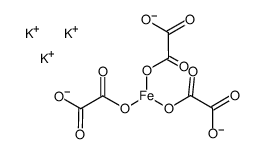5936-11-8
| Name | potassium trioxalatoferrate(iii) |
|---|---|
| Synonyms |
EINECS 238-954-7
MFCD00150450 |
| Density | 2.133^2^0 |
|---|---|
| Melting Point | 100ºC (loss of 3 H2O) |
| Molecular Formula | C6FeK3O12 |
| Molecular Weight | 437.19700 |
| Exact Mass | 436.76500 |
| PSA | 199.29000 |
|
Section 1: Product Identification Chemical Name:Potassium tris(oxalato)ferrate(III) trihydrate CAS Registry Number:5936-11-8 Formula:K3Fe(C2O4)3.3H2O EINECS Number:none Chemical Family:organometallic complexes Synonym:Ferrate(3-), tris(oxalato)-, potassium
Section 2: Composition and Information on Ingredients IngredientCAS NumberPercentACGIH (TWA)OSHA (PEL) Title Compound5936-11-8100%1mg/m3 (as Fe - soluble)no data Section 3: Hazards Identification Emergency Overview:Irritating to skin, eyes and mucous membranes. Harmful if swallowed. Primary Routes of Exposure:Ingestion, eyes Eye Contact:Causes mild to severe irritation of the eyes. Skin Contact:Causes mild to severe irritation of the skin. Inhalation:Dust is irritating to the nose, mucous membranes and respiratory tract. Ingestion:Harmful if swallowed. May cause kidney damage. A mild to severe irritant to skin, eyes and respiratory tract. Ingestion causes severe irritation to the mouth, Acute Health Affects: esophagus and stomach. The toxicological properties of this compound have not been thoroughly investigated. Unrecognized hazards Chronic Health Affects: may be present. NTP:No IARC:No OSHA:No SECTION 4: First Aid Measures Immediately flush the eyes with copious amounts of water for at least 10-15 minutes. A victim may need Eye Exposure: assistance in keeping their eye lids open. Get immediate medical attention. Wash the affected area with water. Remove contaminated clothes if necessary. Seek medical assistance if Skin Exposure: irritation persists. Remove the victim to fresh air. Closely monitor the victim for signs of respiratory problems, such as difficulty Inhalation: in breathing, coughing, wheezing, or pain. In such cases seek immediate medical assistance. Seek medical attention immediately. Keep the victim calm. Give the victim water (only if conscious). Induce Ingestion: vomiting only if directed by medical personnel. SECTION 5: Fire Fighting Measures Flash Point:no data Autoignition Temperature:no data Explosion Limits:no data Extinguishing Medium:dry chemical, carbon dioxide, or foam. If this product is involved in a fire, fire fighters should be equipped with a NIOSH approved positive pressure Special Fire Fighting Procedures: self-contained breathing apparatus and full protective clothing. Hazardous Combustion andIf involved in a fire this material may emit toxic and corrosive fumes. Decomposion Products: Unusual Fire or Explosion Hazards: No unusual fire or explosion hazards. SECTION 6: Accidental Release Measures Spill and Leak Procedures:Small spills can be mixed with powdered sodium bicarbonate, lime, or calcium carbonate and swept up. SECTION 7: Handling and Storage Handling and Storage:Store in a cool, dry place in a tightly sealed container away from light. SECTION 8: Exposure Controls and Personal Protection Eye Protection:Always wear approved safety glasses when handling a chemical substance in the laboratory. Skin Protection:Wear appropriate chemical resistant gloves and protective clothing. Ventilation:Material may form a fine dust. If possible, handle the material in an efficient fume hood. If ventilation is not available a respirator should be worn. The use of respirators requires a Respiratory Respirator: Protection Program to be in compliance with 29 CFR 1910.134. Ventilation:Material may form a fine dust. If possible, handle the material in an efficient fume hood. Additional Protection:No additional protection required. SECTION 9: Physical and Chemical Properties Color and Form:green xtl Molecular Weight:437.20 (491.25) Melting Point:no data Boiling Point:no data Vapor Pressure:no data Specific Gravity:no data Odor:none Solubility in Water:very soluble SECTION 10: Stability and Reactivity Stability:light sensitive Hazardous Polymerization:no hazardous polymerization Conditions to Avoid:none Incompatibility:oxidizing agents and active metals Decomposition Products:iron oxide, potassium carbonate, and carbon monoxide SECTION 11: Toxicological Information RTECS Data:No information available in the RTECS files. Carcinogenic Effects:no data Mutagenic Effects:no data Tetratogenic Effects:no data SECTION 12: Ecological Information Ecological Information:No information available SECTION 13: Disposal Considerations Disposal:Dispose of according to local, state and federal regulations. SECTION 14: Transportation Shipping Name (CFR):Non-hazardous Hazard Class (CFR):NA Additional Hazard Class (CFR):NA Packaging Group (CFR):NA UN ID Number (CFR):NA Shipping Name (IATA):Non-hazardous Hazard Class (IATA):NA Additional Hazard Class (IATA):NA Packaging Group (IATA):NA UN ID Number (IATA):NA SECTION 15: Regulatory Information TSCA:Not listed in the TSCA inventory SARA (Title 313):Title compound not listed Second Ingredient:none SECTION 16 - ADDITIONAL INFORMATION N/A |
| Hazard Codes | Xi |
|---|---|
| Risk Phrases | 36/37/38 |
| Safety Phrases | 26-36/37/39 |
| RIDADR | UN 3288 |
| Packaging Group | III |
| Hazard Class | 6.1 |
